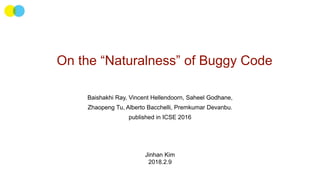Review: On the Naturalness of Buggy Code
- 1. On the ŌĆ£NaturalnessŌĆØ of Buggy Code Baishakhi Ray, Vincent Hellendoorn, Saheel Godhane, Zhaopeng Tu, Alberto Bacchelli, Premkumar Devanbu. published in ICSE 2016 Jinhan Kim 2018.2.9
- 2. Naturalness ŌĆó Real software tends to be natural, like speech or natural language. ŌĆó It tends to be highly repetitive and predictable. Naturalness of Software1 [1] A. Hindle, E. Barr, M. Gabel, Z. Su, and P. Devanbu. On the naturalness of software. In ICSE, pages 837ŌĆō847, 2012.
- 3. What does it mean when a code is considered ŌĆ£unnaturalŌĆØ?
- 4. Research Questions ŌĆó Are buggy lines less ŌĆ£naturalŌĆØ than non-buggy lines? ŌĆó Are buggy lines less ŌĆ£natural" than bug-fix lines? ŌĆó Is ŌĆ£naturalness" a good way to direct inspection effort?
- 5. Background
- 6. Language Model ŌĆó Language model assign a probability to every sequence of words. ŌĆó Given a code token sequence, Øæå = ØæĪ1 ØæĪ2 ŌĆ” ØæĪ Øæü
- 7. ngram Language Model ŌĆó Using only the preceding n - 1 tokens. ŌĆó ŌäÄ = ØæĪ1 ØæĪ2 ŌĆ” ØæĪØæ¢ŌłÆ1
- 8. $gram Language Model2 ŌĆó Improving language model by deploying an additional cache- list of ngrams extracted from the local context, to capture the local regularities. [2] Z. Tu, Z. Su, and P. Devanbu. On the localness of software. In SIGSOFT FSE, pages 269ŌĆō280, 2014.
- 9. Study
- 10. Study Subject
- 11. Phase-1 (during active development) ŌĆó They chose to analyze each project for the period of one-year which contained the most bug fixes in that projectŌĆÖs history. ŌĆó Then, extract snapshots at 1-month intervals.
- 12. Data Collection
- 14. Entropy Measurement ŌĆó $gram ŌĆó The line and file entropies are computed by averaging over all the tokens belong to a line and all lines corresponding to a file respectively.
- 15. Entropy Measurement ŌĆó Package, class and method declarations ŌĆó previously unseen identifiers ŌĆō higher entropy scores ŌĆó For-loop statements and catch clauses ŌĆó being often repetitive ŌĆō lower entropy scores Abstract-syntax-based line-types and computing a syntax-sensitive entropy score
- 16. Syntax-sensitive Entropy Score ŌĆó Matching between line and AST node. ŌĆó Then, compute how much a lineŌĆÖs entropy deviated from the mean entropy of its line-type. ŌĆó => $gram+type
- 17. Relative bug-proneness ŌĆó => $gram+wType
- 18. Evaluation
- 19. RQ1: Are buggy lines less ŌĆ£natural" than non-buggy lines?
- 20. Are buggy lines less ŌĆ£natural" than non-buggy lines?
- 21. Bug Duration
- 22. Bug Duration Bugs that stay longer in a repository tend to have lower entropy than the short-lived bugs
- 23. RQ2: Are buggy lines less ŌĆ£natural" than bug-fix lines?
- 24. Are buggy lines less ŌĆ£natural" than bug-fix lines?
- 25. Example 1
- 26. Example 2
- 27. Example 3
- 28. Counterexample
- 29. RQ3: Is ŌĆ£naturalness" a good way to direct inspection effort?
- 30. DP: Defect Prediction ŌĆó Two classifier ŌĆó Logistic Regression(LR) ŌĆó Random Forest(RF) ŌĆó Process metrics ŌĆó # of developers ŌĆó # of file-commit ŌĆó Code churn ŌĆó Previous bug history
- 31. SBF: Static Bug Finder ŌĆó SBF uses syntactic and semantic properties of source code. ŌĆó For this study, PMD and FindBugs are used. ŌĆó NBF: Naturalness Bug Finder ŌĆó AUCEC: Area Under the Cost-Effectiveness Curve
- 34. Result ŌĆó Buggy lines, on average, have higher entropies, i.e. are ŌĆ£less naturalŌĆØ, than non-buggy lines. ŌĆó Entropy of the buggy lines drops after bug-fixes with statistical significance. ŌĆó Entropy can be used to guide bug-finding efforts at both the file- level and the line-level.
- 35. Appendix

![Naturalness
ŌĆó Real software tends to be natural, like speech or natural
language.
ŌĆó It tends to be highly repetitive and predictable.
Naturalness of Software1
[1] A. Hindle, E. Barr, M. Gabel, Z. Su, and P. Devanbu. On the naturalness of software. In ICSE, pages 837ŌĆō847,
2012.](https://image.slidesharecdn.com/onthenaturalnessofbuggycode-181109070142/85/Review-On-the-Naturalness-of-Buggy-Code-2-320.jpg)





![$gram Language Model2
ŌĆó Improving language model by deploying an additional cache-
list of ngrams extracted from the local context, to capture the
local regularities.
[2] Z. Tu, Z. Su, and P. Devanbu. On the localness of software. In SIGSOFT FSE, pages 269ŌĆō280, 2014.](https://image.slidesharecdn.com/onthenaturalnessofbuggycode-181109070142/85/Review-On-the-Naturalness-of-Buggy-Code-8-320.jpg)


























